
Hail Activity in Colorado Springs, CO
Over the past 12 months, the Colorado Springs area has experienced significant hail activity. Trained spotters have reported 528 instances of hail on the ground, and the region has been under severe weather warnings 68 times. Additionally, Doppler radar has identified hail in or near Colorado Springs on 198 occasions, 16 of which occurred within the last year.
Location Details:
• City: Colorado Springs, CO
• Distance: 43.1 miles north of Pueblo, CO
• Population: 416,427
• Housing Units: 179,607
• Map: View on Google Maps
The Top Recent Hail Date for Colorado Springs, CO is Sunday, July 7, 2024 (36th out of 198)

On-the-Ground Hail Reports
Number of Reports: 7
Average Size Reported: 1.29″
Max Size Reported: 1.75″
Protect Your Colorado Springs Property from Hail Damage!
If you suspect your property has damage from this storm contact us
2020 HAIL REPORTS NEAR OKLAHOMA DENVER, COLORADO
2021 HAIL REPORTS NEAR Denver. No reports of hail activity found within 10 miles of Denver, Colorado in 2021
Hail Reports (Rotate your phone horizontal)
| Details | Date | Size | City | County | |
|---|---|---|---|---|---|
| 03/12/2021 | 0.00 inches | Denver | Denver | CO | |
03/12/2021 Wind Reports (Rotate your phone horizontal)
2021 WIND REPORTS NEAR Denver, Colorado No reports of wind activity found within 10 miles of Denver, Colorado in 2021.
| Date | Speed | City | County | State |
|---|---|---|---|---|
| 03/12/2021 6:25 A | mph | Denver | CO | |
03/12/2021 Tornado Reports (Rotate your phone horizontal)
2020 TORNADO REPORTS NEAR Denver, CO. No Reports of tornado activity found within 10 miles of Denver, Colorado in 2020
List of costly or deadly hailstorms in Denver Colorado
| 11 July 1990 | Denver, Colorado, USA | Softball-sized hail destroyed roofs and cars, causing $625 million in total damage ($1.1 billion in damage adjusted to 2013 dollars) |
| 20 July 2009 | Denver, Colorado, USA | A hailstorm in the western suburbs of Denver caused $770 million (USD) damage. |
| 8 May 2017 | Denver, Colorado, USA | In what is now the most catastrophic storm in state history, baseball-sized stones pummeled the west Denver Metro area, resulting in extensive damage to homes, windows, vehicles (many of which were in the late day commute), and roofs. The storm would surpass the state’s costliest wildfires, force the closure of the Colorado Mills Mall until the end of 2017, and caused $2.3 billion in damage. |
Colorado Springs 2021 Hail Summary
Colorado Springs, Colorado (population: 416427) had 3 hail reports within 10 miles of the city center located at (38.83388, -104.82136) in 2021. The largest report of hail in 2021 near Colorado Springs was 1.75 inches about 6 days ago. The zipcode with the highest number of damaging hail reports near Colorado Springs in 2021 is 80916, with 2 reports.
The last time that hail was reported near Colorado Springs was on 05/02/2021.
If your property has damage from this storm contact us
A few other cities and towns near Colorado Springs that may also have damaging hail reports:
Security-Widefield, Fountain, Cimarron Hills, Fort Carson, Black Forest, Woodmoor, Woodland Park, Stratmoor, Air Force Academy, and Gleneagle
2021 COLORADO SPRINGS, COLORADO HAIL MAP
2021 HAIL REPORTS NEAR COLORADO SPRINGS, COLORADO
05/02/2021 Hail Reports (Rotate your phone horizontal)
| Details | Date | Size | City | County | State |
|---|---|---|---|---|---|
| Details Below | 05/02/2021 2:31 p | 1.75 in. | COS | el paso | CO |
| Details Below | 05/02/2021 4:43 p | 1.00 in. | COS | el paso | CO |
| Details Below | 05/02/2021 2:25 p | 1.00 in. | COS | el paso | CO |
| report from mping: 1/4 (1.00 in.). (pub) |
| Date | Report Details |
|---|---|
| 5/2/2021 3:43 PM MDT | Quarter sized hail reported 6.9 miles NNW of Colorado Springs, CO |
| 5/2/2021 1:48 PM MDT | At 148 pm mdt, a severe thunderstorm was located near fountain, or 15 miles southeast of colorado springs, moving east at 20 mph (radar indicated). Hazards include 60 mph wind gusts and half dollar size hail. Hail damage to vehicles is expected. expect wind damage to roofs, siding, and trees. Locations impacted include, southeastern colorado springs, fountain, schriever afb and hanover. |
| 5/2/2021 1:37 PM MDT | At 137 pm mdt, a severe thunderstorm was located near security-widefield, or 12 miles southeast of colorado springs, moving east at 20 mph (radar indicated). Hazards include ping pong ball size hail and 60 mph wind gusts. People and animals outdoors will be injured. expect hail damage to roofs, siding, windows, and vehicles. Expect wind damage to roofs, siding, and trees. |
| 5/2/2021 1:31 PM MDT | Golf Ball sized hail reported 4.6 miles NW of Colorado Springs, CO |
| 5/2/2021 1:30 PM MDT | At 130 pm mdt, a severe thunderstorm was located over southeastern colorado springs, moving northeast at 20 mph (trained weather spotters). Hazards include golf ball size hail. People and animals outdoors will be injured. expect damage to roofs, siding, windows, and vehicles. Locations impacted include, southeastern colorado springs, fountain, ellicott, schriever afb, peterson afb, falcon, security-widefield and cimarron hills. |
| 5/2/2021 1:25 PM MDT | Quarter sized hail reported 6.9 miles NNW of Colorado Springs, CO, report from mping: quarter (1.00 in.). |
| 5/2/2021 1:20 PM MDT | At 119 pm mdt, a severe thunderstorm was located over southeastern colorado springs, moving northeast at 20 mph (trained weather spotters. quarter size hail was reported at flying horse ranch). Hazards include quarter size hail. damage to vehicles is expected |
| 5/2/2021 1:18 PM MDT | Quarter sized hail reported 10 miles S of Colorado Springs, CO, report from mping: quarter (1.00 in.). |
2021 WIND REPORTS NEAR COLORADO SPRINGS, COLORADO No reports of wind activity found within 10 miles of Colorado Springs, Colorado in 2021.
2021 TORNADO REPORTS NEAR COLORADO SPRINGS, COLORADO No Reports of tornado activity found within 10 miles of Colorado Springs, Colorado in 2021
Why does Colorado get so much hail?
One reason we are so prone to hail is our altitude. Because Colorado has such a high average elevation we are closer to the freezing level in the atmosphere. This allows strong updrafts to reach the hail producing region of a cloud.
Another reason is the cloud itself and the processes taking place. We tend to have cold, mixed-phase clouds over Colorado during the summer, as opposed to warm clouds that are all liquid, which you will find in the tropics and sub-tropics on Earth. (more on mixed-phase clouds in a bit)
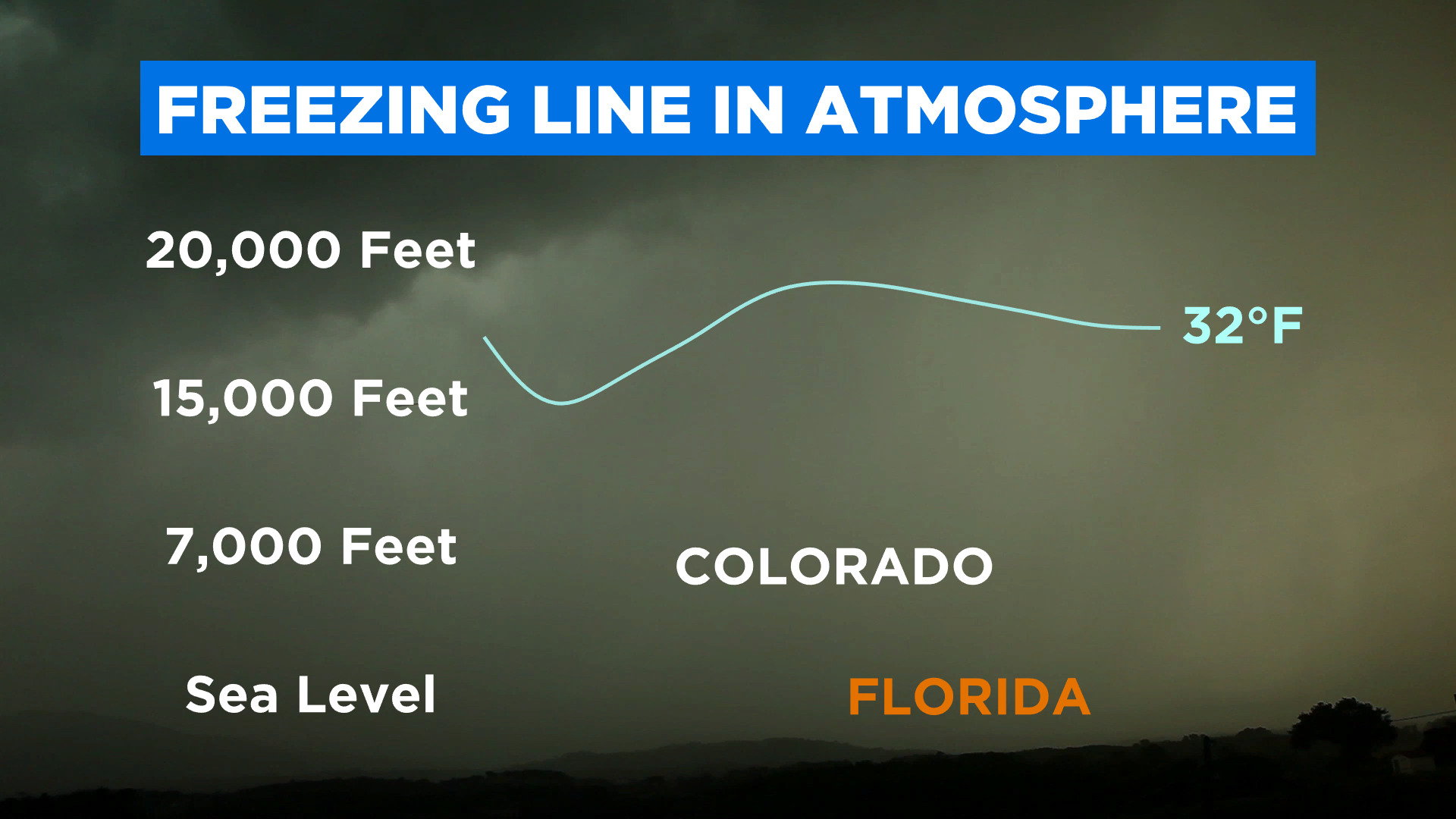
The Front Range of the Rocky Mountains and the adjacent high plains is known as the ‘hail capital’ of North America. We have as many as 7-9 days each season with hail. While the frequency of hail is high the average size is usually small. But on some days strong southeast winds at the surface can transport large amounts of water vapor to the plains which sets the stage for the potential to see large hail.
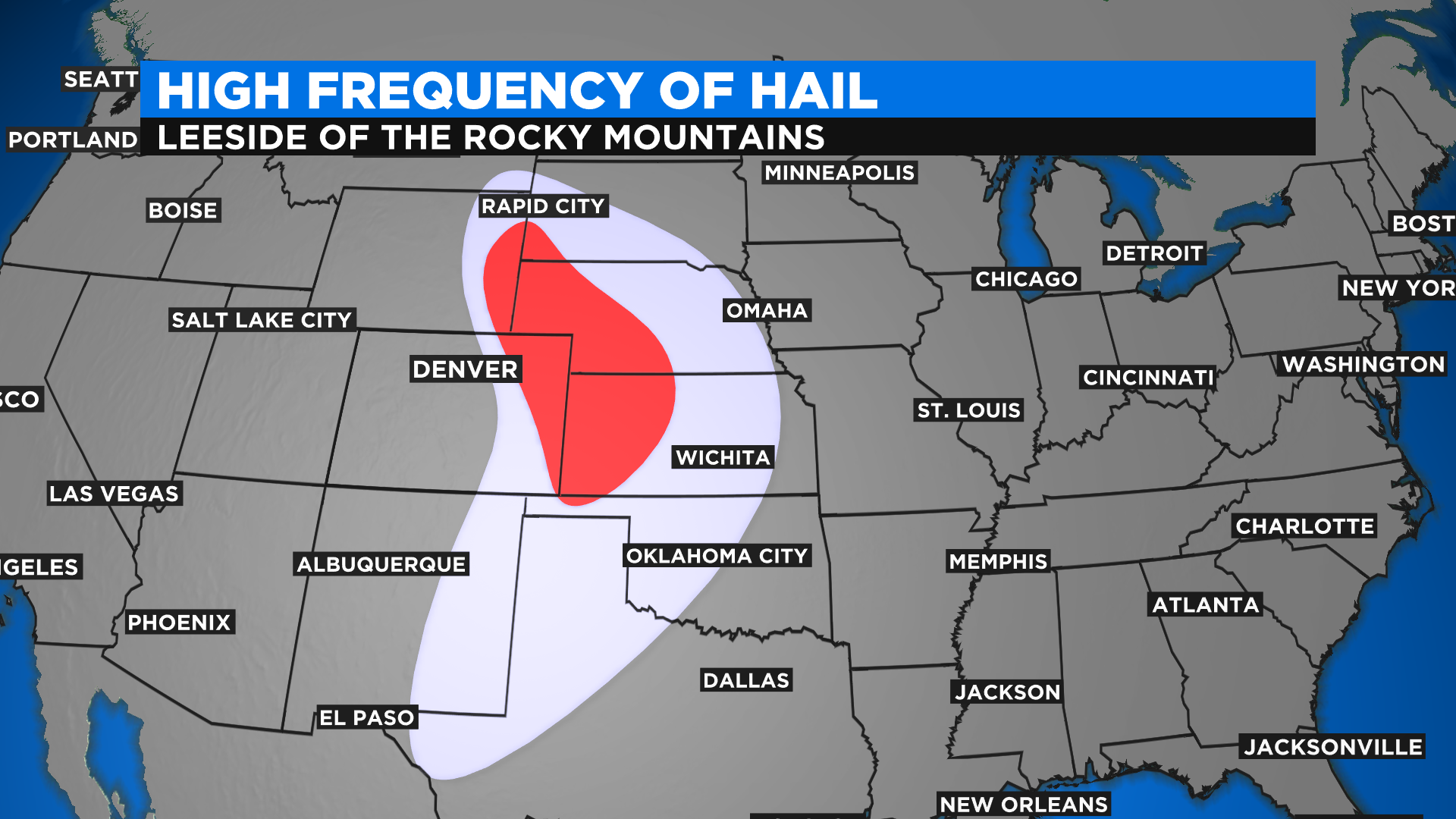
A major hailstorm hit Colorado’s eastern plains on August 13, 2019 and dropped a hailstone large enough to set a new state record. The 4.83 inch (diameter) piece of ice fell in the small town of Bethune.
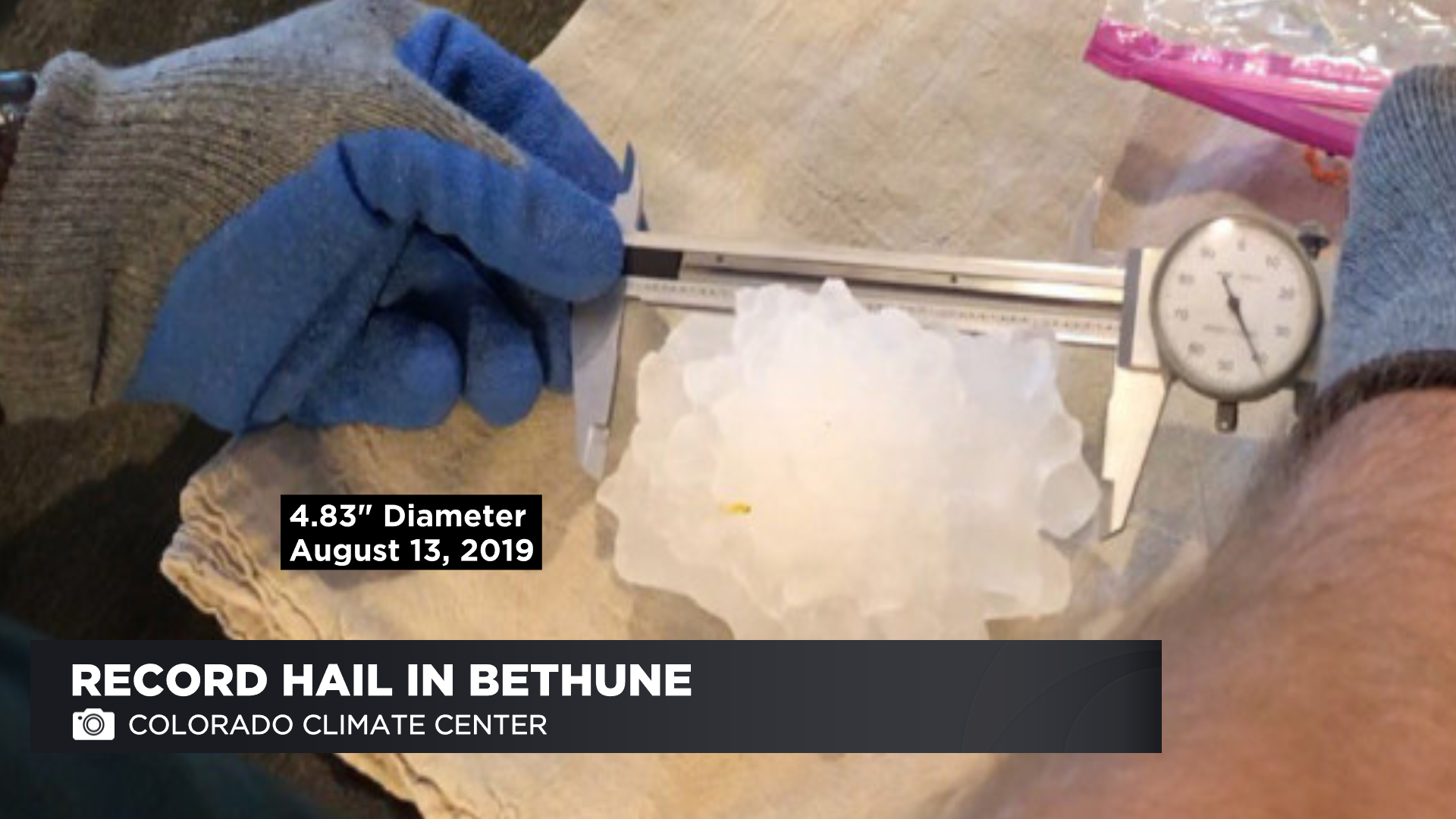
Hail can fall at any elevation in Colorado and it is most common in June, but hail can fall as early as March and as late as October. We often see balls of ice fall during some winter storms and often times people will call this hail, but it is really graupel, a piece of ice that forms in the cloud from a process that is similar to, but different than the process that forms hail.
Large hail is most common along and east of Interstate 25 where moisture to fuel storms is usually most abundant. Hail in the mountains is normally soft and small but it can occasionally reach severe thunderstorm criteria, which a 1-inch or larger in diameter.
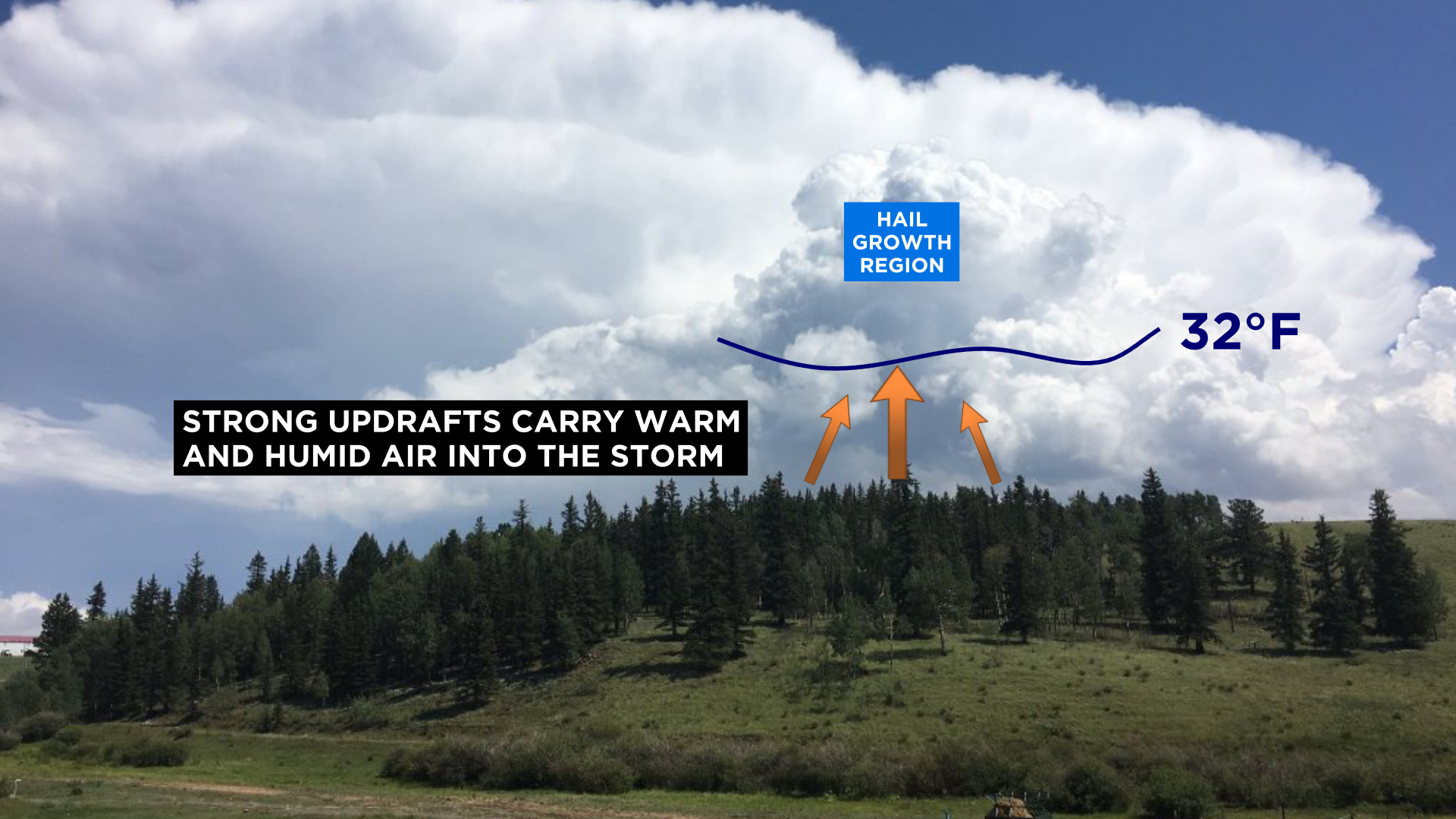
The process for getting hail begins with a strong updraft associated with an intensifying thunderstorm. The rising air transports copious amounts of atmospheric moisture high into the storm cloud to an area known as the hail growth region.
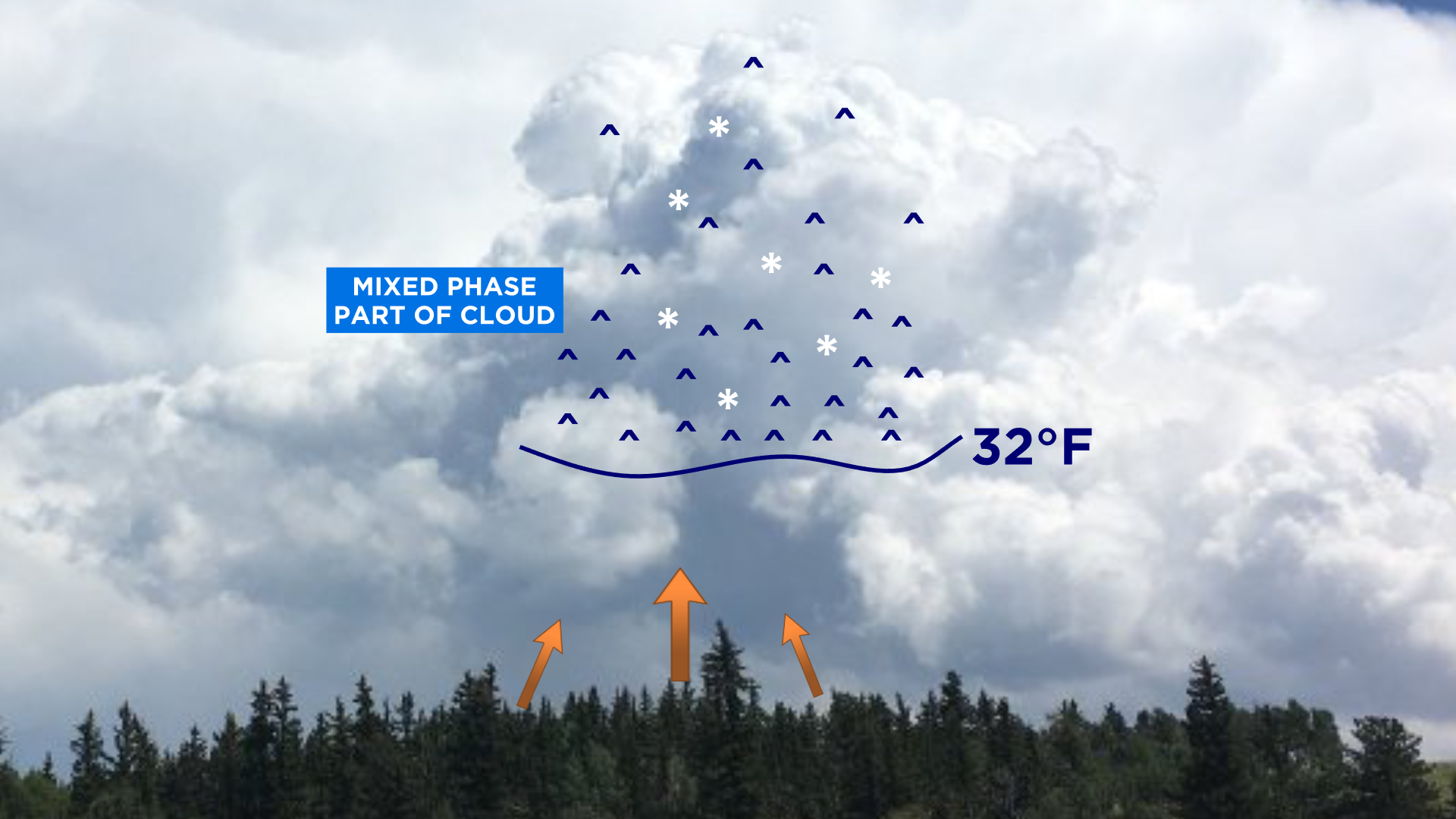
The hail growth region is located inside of a mixed-phase cloud, meaning there are super cooled liquid water droplets (cloud droplets) and small pieces of ice or ice nuclei in the same space. This sets the stage for a process called accretion to take place which allows the hail to grow. It’s another reason why we are so hail prone. Our altitude gives us these mixed-phase clouds that allow ice to grow during a summer thunderstorm.
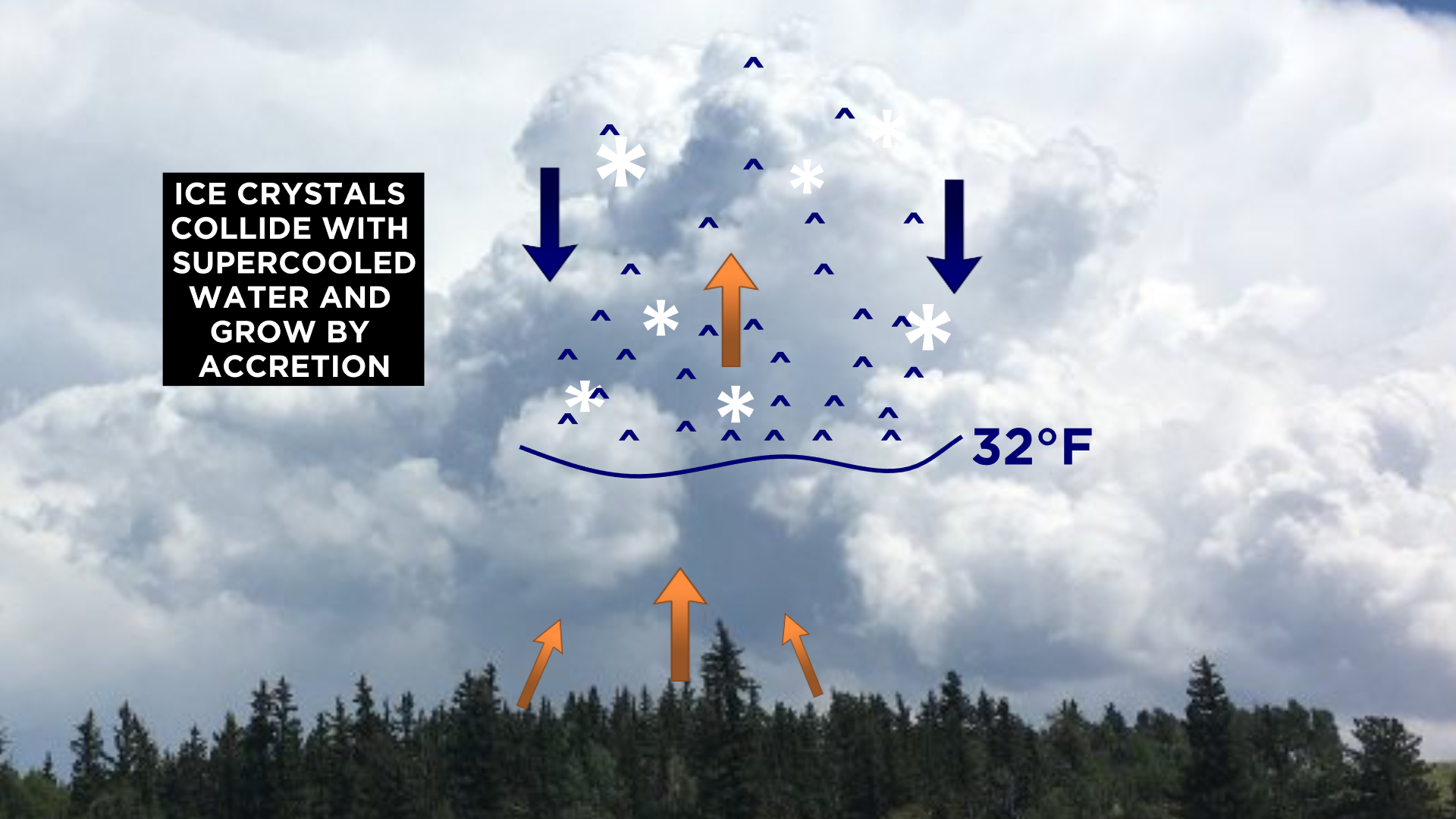
As hailstones grow inside the cloud they become bigger and bigger over time and will eventually grow so large that the updraft can no longer keep them suspended aloft. This is when they fall to the ground. The stronger the updraft the bigger the hail can grow.
If you examine a hailstone closely it will tell a story about how long it was inside the cloud. With each pass up and down through the storm the hailstone will pass through various temperature layers, causing the ice to freeze fast or slow.
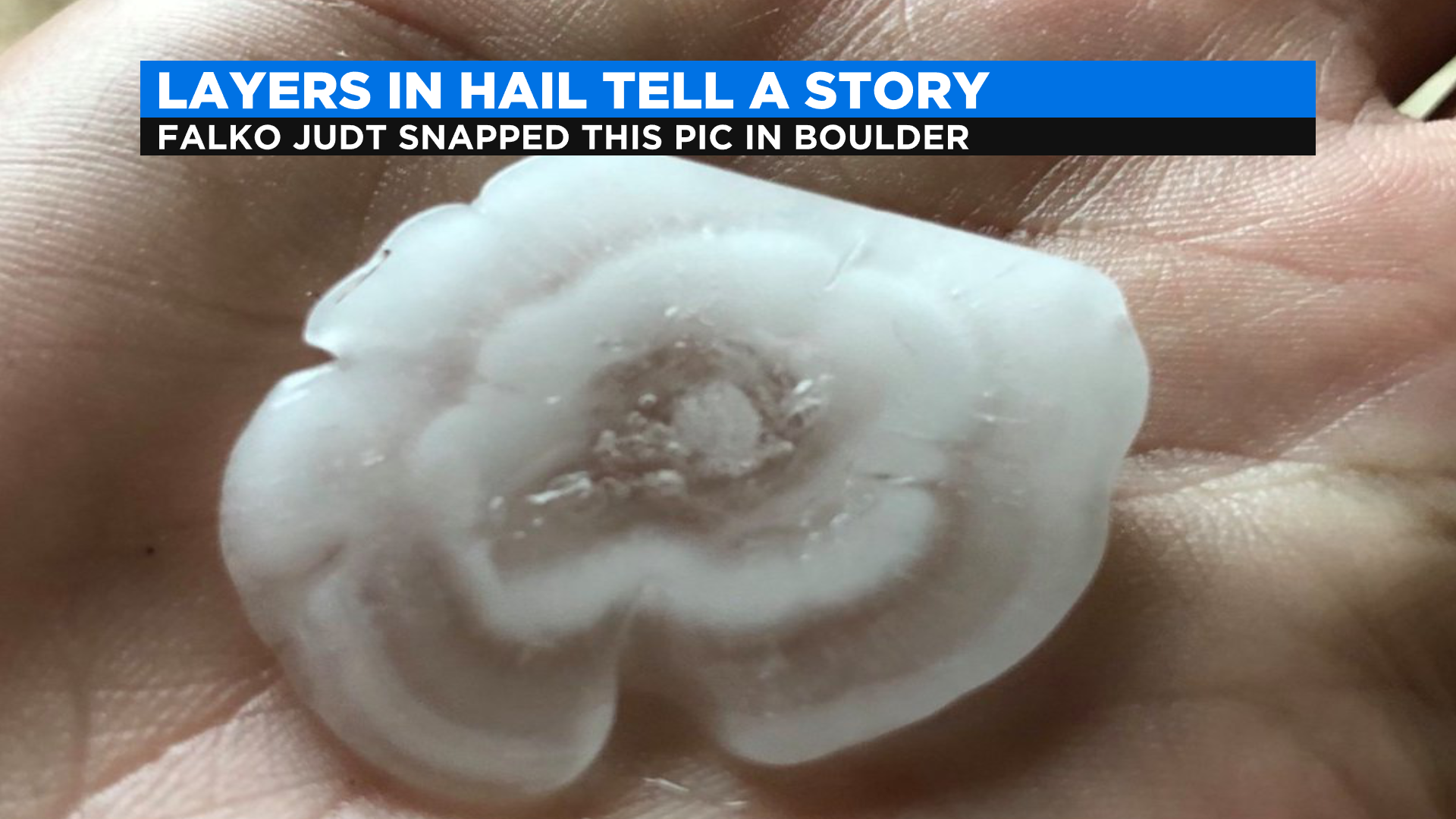
Higher up in the cloud where the air is colder super cooled water droplets will freeze on contact with the hail. This is a very fast process and results in a cloudy layer of ice. It’s cloudy because air bubbles get trapped inside.
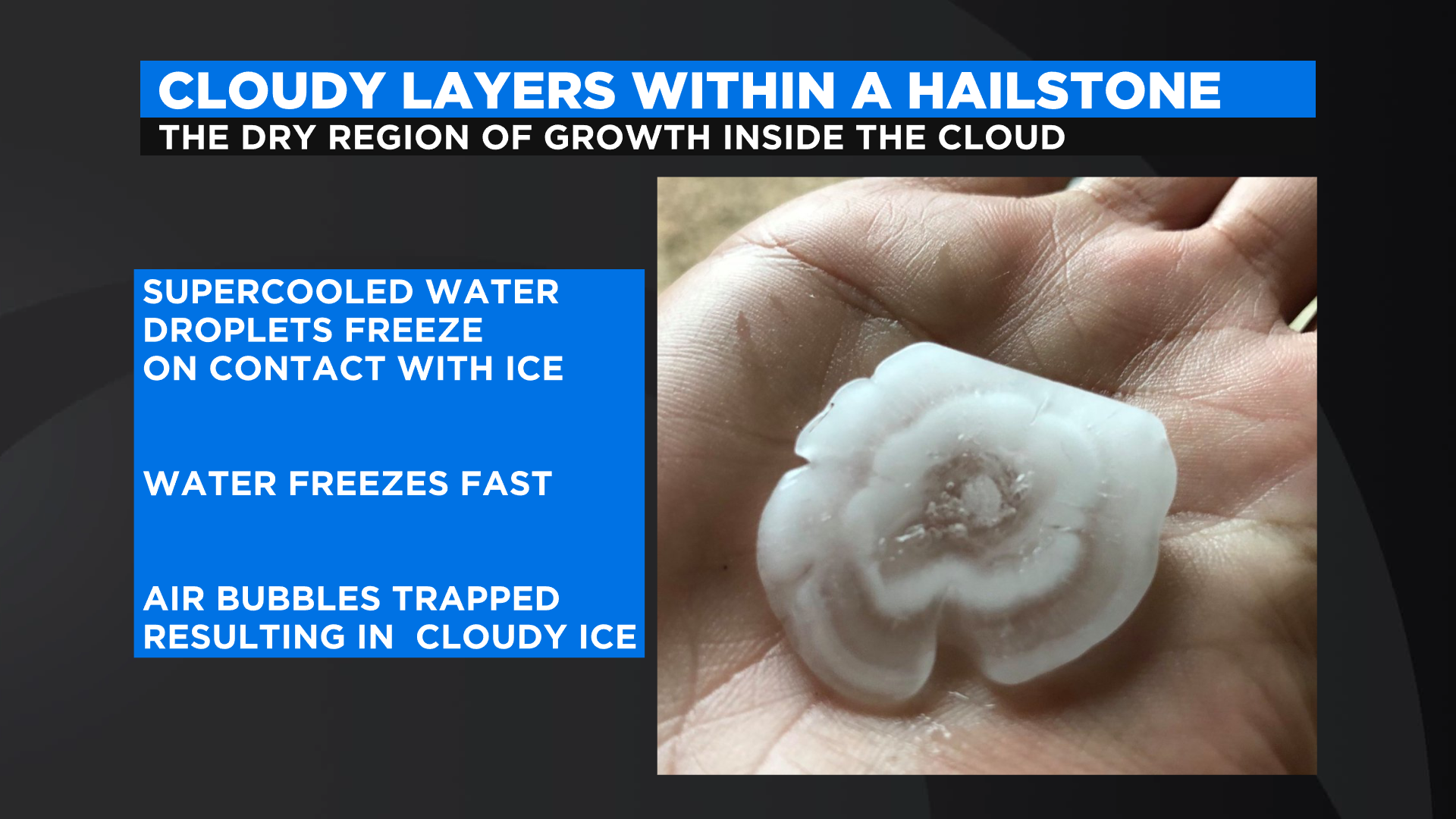
But lower in the cloud where the air is warmer and there is a lot more water vapor available the freezing process is much slower. This allows the air bubbles to escape and results in a clear layer of ice.

Notable weather Events in Colorado
| 11 July 1990 | Denver, Colorado, USA | Softball-sized hail destroyed roofs and cars, causing $625 million in total damage ($1.1 billion in damage adjusted to 2013 dollars). |
| 20 July 2009 | Denver, Colorado, USA | A hailstorm in the western suburbs of Denver caused $770 million (USD) damage. |
Schedule Your Free Consultation
Our project specialist will call you to get the details of your project. They’ll answer all your questions and help you select the products that are right for your project and your budget.






